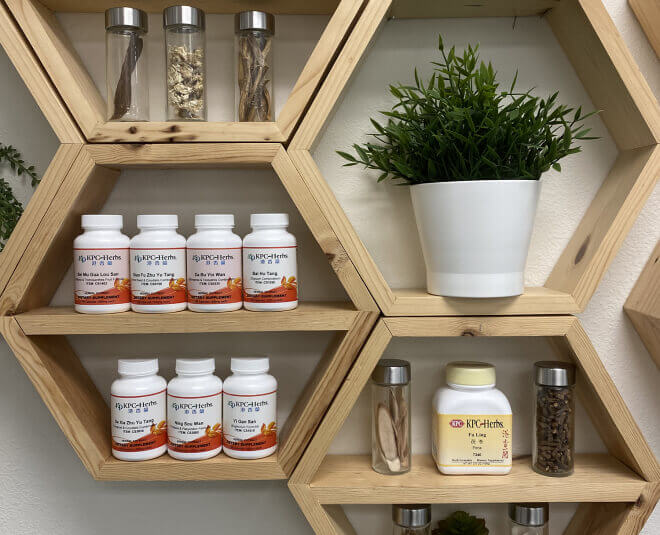“KP insists on using gas chromatograph/mass spectrometry because of its higher sensitivity and more precise and reliable results”

Quality
QA & Safety
For thousands of years, herbs have been used, studied, and celebrated for their therapeutic properties. Yet, the rapid industrialization over the past two centuries has dramatically changed the natural environment and the methods for the cultivation of herbs. Long ago, herbs were cultivated organically because of a lack of industrial means. Industry has greatly increased the productivity of farmers, but herbs now face threats to their safety and integrity from exposure to chemicals and industrial runoff. This includes industrial waste released into the environment and the chemical pesticides and fertilizers used by farmers to promote better yields.
KP’s top priority is guarding against these threats and ensuring the safety of their herbal products. KP believes all herb vendors share this responsibility. KP’s herbal products have gone through the world’s most rigorous testing standards and inspection processes. KP’s herbs pass tests for the full range of today’s contaminants. Tests include analysis for heavy metals, dangerous pesticides, sulfur dioxide, aflatoxins and aristolochic acid. These tests are integrated into their manufacturing process.
A Certificate of Analysis (COA) is produced with each batch of herbs. The COA documents the excellent quality of their herbal extracts. Only batches that fulfill the ‘Golden Standard’ are packaged and distributed. The Golden Standard is a collection of the strictest criteria of the safety standards from the U.S., Singapore, the E.U. and Japan. The high standard ensures KP’s herbal products may be consumed safely across the world, making them truly world-class.
KP’s products represent over a century of expertise in the selection of herbs. This experience is combined with a state-of-the-art quality control system at the forefront of scientific development.
“KP’s products have gone through the world’s most rigorous testing standards and inspection process.”
Species Authentication
Authentication is the determination of the correct species, origin and quality of Chinese herbs. KP’s authentication process aims to prevent the use of inauthentic herbs, whether by mistaken identification or the substitution of imitation products.
KP’s authentication method is modeled not only after the foundation books of TCM, but also in accordance with each country’s particular standards for quality and inspection methods. The authentication method also uses technology specified for detection of the correct origin and species of the Chinese herbs.
KP performs the following methods of authentication on raw herbs:
- Appearance
- Microscopic analysis
- Physical/chemical identification
- Chemical Fingerprinting
KP has invested heavily in chemical fingerprinting technologies, as the technologies play a vital role in safety and the future of the herbal industry. KP applies the techniques of Thin-layer chromatography (TLC), High-performance liquid chromatography-mass spectrometry (HPLC-MS), and Gas chromatography-mass spectrometry/mass spectrometry (GC-MS/MS) to authenticate the species identity of herbs.
KP integrates expertise of both expert evaluations and technological applications. Experts use traditional methods of inspection to analyze the herb’s exterior, color and grain. Technicians also implement state-of-the-art technology and cutting-edge applied science to make objective assessments of quality. KP’s quality control is integrated and proven. Strength in quality control is the basis for the globalization of KP’s business and the guarantee of safety of TCM herbs. Consumers can trust that KP’s unparalleled quality control system is strictly enforced from starting ingredients to finished products.
“KP employs expertise both in traditional methods of inspection as well as analytical methods made possible by modern advancements in science.”
Sulfur Dioxide Detection
Chinese herbs derive from natural plants. Like any plant material, herbs are vulnerable to mold and insect infestation, especially when stored in poor conditions. Mold or infestation can ruin a crop and mean a financial loss for a farmer of herbs. To counteract mold and infestation, many Chinese-mainland farmers fumigate their herbs with sulfur-based vapors. The resulting sulfur dioxide wipes out existing pathogens and bacteria and halts decay from insects and herbs, acting as a chemical preservative. The gas is able to reach even unexposed spaces. The application of sulfur dioxide, however, alters the very nature of the herbs. Sulfur dioxide bleaches the herbs Dioscorea (shan yao), Pueraria Root (ge gen) and dried ginger (gan jiang).
KP opposes the use of sulfur dioxide in herbs because of the serious effects on the nature of Chinese herbs. Sulfur dioxide causes high sugar-content herbs, such as Cibotium (gou ji), to become noticeably more acidic. Sulfur dioxide oxidizes herbs with fatty oils, such as Persica (tao ren), and gives them a pungent oily odor. Sulfur dioxide fumigation also damages the fundamental qualities of fragile herbs such as Chrysanthemum (ju hua).

Sulfur dioxide fumigation also produces some inorganic sulfites as a by-product. For certain individuals, sulfites can cause adverse reactions and harmful side effects such as diarrhea, allergic reactions and asthma. KP takes actions to prevent sulfur fumigation from being applied to its raw herbs. KP takes many precautions to keep sulfur fumigation from its herbs, because it can jeopardize the quality and safety of the herbal products.
KP’s quality control teams analyze herbs for sulfur dioxide. KP employs the following methods: aerated-oxidization, iodine titration, atomic absorption spectroscopy and direct color comparison. KP uses the Rankine method for sulfur dioxide residue analysis. In this method, the herbal sample is reacted with acid and then distilled. The sulfur dioxide is absorbed into the oxidized Hydrogen Peroxide (H2O2). The resultant sulfuric base is titrated with a standard base. The resulting colors determine the sulfur content: olive green indicates no oxidized sulfur residue while a purplish-red color indicates a presence of oxidized sulfuric acid.

Pesticide Residuals Detection
Chemical pesticides are generally classified into organochlorine, organophosphate, carbamate and pyrethin. Of these, organochlorine pesticides have the longest history of use, are most potent in effectiveness, and are also the most harmful to human health. Although many organochlorine pesticides are already forbidden by law, their persistent nature resists being broken down and can remain in the environment long after use. KP takes a comprehensive approach to testing for pesticides.
KP’s labs test not just for the chemical compounds in the pesticide itself, but also test for the by-product chemical compounds. Pesticide analysis must anticipate all potentially harmful chemical changes produced in the plant to be truly effective. The techniques generally employed to detect pesticide residuals are thin-layer chromatography (TLC) or gas chromatography. TLC is used in most general cases because it is simple and easy to execute. Yet KP insists on using gas chromatography because of its high sensitivity, precision, and more reliable results.
Aflatoxin Detection
Aspergillus flavus is a fungus that occurs in pesticides, soil, corn, peanuts, hay and animal organs. Aspergillus flavus has also been found in Chinese herbs such as corydalis (yan hu suo), cyperus (xiang fu) and jujube (da zao). It thrives especially in warm temperatures of 77–86°F, a relative humidity above 75% and a pH level above 5.6. The fungus can actually grow in temperatures as low as 54° but will not be toxic.
Strains of the fungi Aspergillus flavus and Aspergillus parasiticus produce aflatoxins. Researchers have determined that four kinds of aflatoxins are highly toxic and possibly carcinogenic; they have been classified into categories B1, B2, G1 and G2. To identify the type of aflatoxin, the sample is dissolved in chloroform. If the substance then exhibits a blue color when exposed under UV light, then it is either B1 or B2. If it exhibits a yellow-green color, then it is the G1 or G2 type.
KP enforces strict international regulation standards. Aflatoxin testing is performed on all herbs at risk of contamination. KP values high-quality premium herbs, and herbs that contain unacceptable Aflatoxin levels are discarded. These strict standards keep herbs safe and efficacious for consumers.
“KP values high-quality premium herbs, and herbs that contain unacceptable Aflatoxin levels are discarded.”
Heavy Metal Detection
Herbs have been used medicinally in China for thousands of years. Hundreds of years ago, herbs grew in nature organically, without any risk of contamination by pesticides or other pollutants. With the industrialization of agriculture and expansion of the chemical industry, the situation has changed. Industrial waste and pesticides can add dangerous chemicals to herbs. Even indirect waste – such as acid rain and contaminated groundwater – can dangerously alter herbs. Along with industry’s growth, the danger of heavy metals in herbs has become an acute concern.
Heavy metals refer to metallic chemical elements that have a high density and are highly toxic. KP takes precautions to audit its suppliers’ products to ward against heavy metals. Once herbs reach KP, they are analyzed as raw herbs and analyzed again post-processing in the form of granules.
KP uses inductively coupled plasma mass spectrometry (ICP-MS) to detect for the five heavy metals that pose the most serious risk toward human health: lead, copper, cadmium, arsenic and mercury. In excessive quantities each of these heavy metals endangers health in different ways.
KP analyzes for heavy metal content in herbs with ICP-MS, a technique much more accurate than those specified in the Chinese Pharmacopeia. KP upholds standards for heavy metals under which KP employees would proudly consume. KP never departs from its strict standards for safety and is always strengthening its standards in favor of safety.
“KP utilizes ICP-MS analysis to detect heavy metal content in herbs, providing a much more accurate measurement than techniques outlined in Chinese Pharmacopeia.”
Aristolochic Acid Detection
While KP is often known for the high quality of its products, it’s often not known how much effort is put into safety. There are many stories of clinics that have misidentified herbs or mistakenly substituted one herb for another. These mistakes can seriously threaten the end consumers. Given the great breadth of Chinese herbal ingredients, clinics may easily be confused when one ingredient has multiple names or when multiple species share the same name. Herbs similar in appearance are sometimes dishonestly manipulated and sold as another herb, or herbs are simply misidentified by the herbalist.
Authenticity of the herb is the precursor to the safety and efficacy of a prescription. In 1993, a Belgian weight loss clinic incorrectly administered aristolochic fangchi (guang fang ji) combined with other weight loss stimulants. Approximately 100 people developed nephropathy, or kidney failure. The kidney failure was linked to the presence of aristolochic acid (AA), the main chemical substance in mistakenly used guang fang ji.

Aristolochiaceae Plant Family
The aristolochiaceae plant family is dispersed across tropical areas. The world contains about 200 subspecies in the family. A few species were commonly used Chinese herbs such as guang fang ji (aristolohchia fang chi), aristolochia mansuriensis, aristolochia contorta bunge or the ripened plant aristolochia debilis sieboldet zuccarini.
Reports indicate that aristolochic acid is a carcinogen. Aristolochic acid is believed to be the primary cause of Belgian Chinese herbs Nephropathy (CHN), as well as incidents of acute fibrosis in the kidney area and urinary tract cancer. It may also possess oncogenic properties. In light of these alarming reports, aristolochic acid is considered a dangerous and toxic substance.
Since 1992, KP has put extra effort into promoting awareness towards the serious dangers of mistaken identification of herbs and the inauthentic herbal products on the market. KP has found more than 20 misidentified herbs on the market in the last decade. As a company that values safety, KP’s quality control teams take authentication and screening for aristolochic acid very seriously.
KP maintains a uniform policy forbidding ingredients with aristolochic acid. KP takes extra precautions toward those herbs that are easily confused with aristolochic-herbs – Stephania tetrandra, Clematis armandi, and Vladimiria souliei. KP’s labs obtain chemical markers to distinguish the authentic herbs from common substitutes. All of KP’s herbs are produced without aristolochic acid according to traditional Chinese preparations.
“KP performs TLC analysis and UPLC-MS-MS analysis to distinguish the authentic herbs from the common substitutes and maintain an inflexible, uniform policy forbidding any ingredients tainted with the presence of aristolochic acid.”
